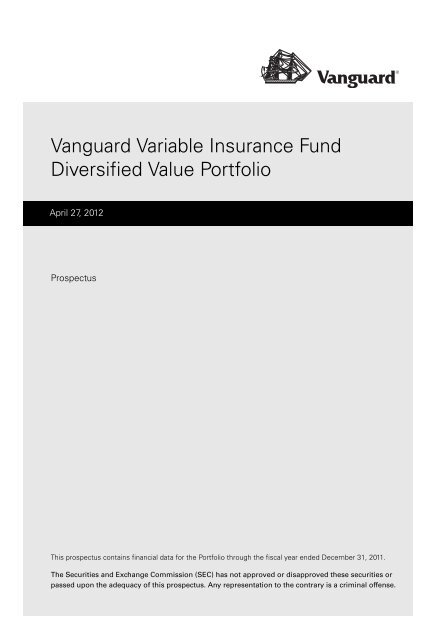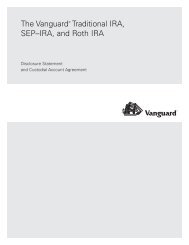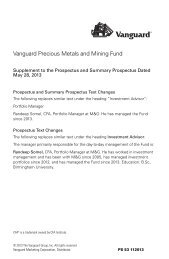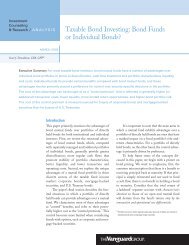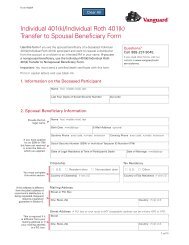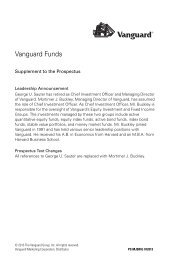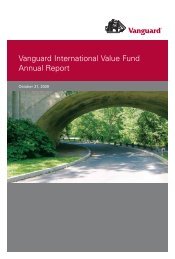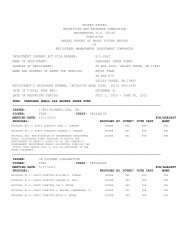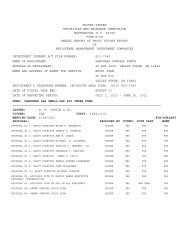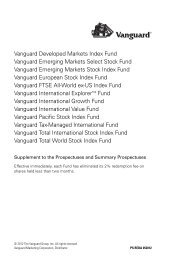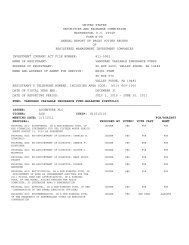Vanguard Variable Insurance Fund Diversified Value Portfolio ...
Vanguard Variable Insurance Fund Diversified Value Portfolio ...
Vanguard Variable Insurance Fund Diversified Value Portfolio ...
You also want an ePaper? Increase the reach of your titles
YUMPU automatically turns print PDFs into web optimized ePapers that Google loves.
<strong>Vanguard</strong> <strong>Variable</strong> <strong>Insurance</strong> <strong>Fund</strong><br />
<strong>Diversified</strong> <strong>Value</strong> <strong>Portfolio</strong><br />
April 27, 2012<br />
Prospectus<br />
This prospectus contains financial data for the <strong>Portfolio</strong> through the fiscal year ended December 31, 2011.<br />
The Securities and Exchange Commission (SEC) has not approved or disapproved these securities or<br />
passed upon the adequacy of this prospectus. Any representation to the contrary is a criminal offense.
Contents<br />
<strong>Portfolio</strong> Summary 1 Financial Highlights 14<br />
More on the <strong>Portfolio</strong> 4 General Information 16<br />
The <strong>Portfolio</strong> and <strong>Vanguard</strong> 10 Glossary of Investment Terms 18<br />
Investment Advisor 11<br />
Taxes 12<br />
Share Price 12
<strong>Portfolio</strong> Summary<br />
Investment Objective<br />
The <strong>Portfolio</strong> seeks to provide long-term capital appreciation and income.<br />
Fees and Expenses<br />
The following table describes the fees and expenses you may pay if you buy and hold<br />
shares of the <strong>Portfolio</strong>. The expenses shown in the table and in the example that<br />
follow do not reflect additional fees and expenses associated with the annuity or life<br />
insurance program through which you invest. If those additional fees and expenses<br />
were included, overall expenses would be higher.<br />
Annual <strong>Portfolio</strong> Operating Expenses<br />
(Expenses that you pay each year as a percentage of the value of your investment)<br />
Management Expenses 0.36%<br />
12b-1 Distribution Fee None<br />
Other Expenses 0.03%<br />
Total Annual Operating Expenses 0.39%<br />
Example<br />
The following example is intended to help you compare the cost of investing in the<br />
<strong>Portfolio</strong> with the cost of investing in other mutual funds. It illustrates the hypothetical<br />
expenses that you would incur over various periods if you invest $10,000 in the<br />
<strong>Portfolio</strong>’s shares. This example assumes that the <strong>Portfolio</strong> provides a return of 5% a<br />
year and that total annual portfolio operating expenses remain as stated in the<br />
preceding table. The results apply whether or not you redeem your investment at the<br />
end of the given period. Although your actual costs may be higher or lower, based on<br />
these assumptions your costs would be:<br />
1 Year 3 Years 5 Years 10 Years<br />
$40 $125 $219 $493<br />
<strong>Portfolio</strong> Turnover<br />
The <strong>Portfolio</strong> pays transaction costs, such as commissions, when it buys and sells<br />
securities (or “turns over” its portfolio). A higher portfolio turnover rate may indicate<br />
higher transaction costs. These costs, which are not reflected in annual portfolio<br />
operating expenses or in the previous expense example, reduce the <strong>Portfolio</strong>’s<br />
performance. During the most recent fiscal year, the <strong>Portfolio</strong>’s turnover rate was 14%.<br />
1
Primary Investment Strategies<br />
The <strong>Portfolio</strong> invests mainly in large- and mid-capitalization companies whose stocks<br />
are considered by the advisor to be undervalued. Undervalued stocks are generally<br />
those that are out of favor with investors and that the advisor feels are trading at<br />
prices that are below average in relation to such measures as earnings and book<br />
value. These stocks often have above-average dividend yields.<br />
Primary Risks<br />
An investment in the <strong>Portfolio</strong> could lose money over short or even long periods. You<br />
should expect the <strong>Portfolio</strong>’s share price and total return to fluctuate within a wide<br />
range, like the fluctuations of the overall stock market. The <strong>Portfolio</strong>’s performance<br />
could be hurt by:<br />
Stock market risk, which is the chance that stock prices overall will decline. Stock<br />
markets tend to move in cycles, with periods of rising prices and periods of falling prices.<br />
Investment style risk, which is the chance that returns from large- and midcapitalization<br />
value stocks will trail returns from the overall stock market. Historically,<br />
mid-cap stocks have been more volatile in price than the large-cap stocks that<br />
dominate the overall market, and they often perform quite differently.<br />
Asset concentration risk, which is the chance that the <strong>Portfolio</strong>’s performance may<br />
be hurt disproportionately by the poor performance of relatively few stocks. The<br />
<strong>Portfolio</strong> tends to invest a high percentage of assets in its ten largest holdings.<br />
Manager risk, which is the chance that poor security selection or focus on<br />
securities in a particular sector, category, or group of companies will cause the<br />
<strong>Portfolio</strong> to underperform relevant benchmarks or other funds with a similar<br />
investment objective.<br />
An investment in the <strong>Portfolio</strong> is not a deposit of a bank and is not insured or<br />
guaranteed by the Federal Deposit <strong>Insurance</strong> Corporation or any other<br />
government agency.<br />
Annual Total Returns<br />
The following bar chart and table are intended to help you understand the risks of<br />
investing in the <strong>Portfolio</strong>. The bar chart shows how the performance of the <strong>Portfolio</strong><br />
has varied from one calendar year to another over the periods shown. The table<br />
shows how the average annual total returns of the <strong>Portfolio</strong> compare with those of a<br />
relevant market index, which has investment characteristics similar to those of the<br />
<strong>Portfolio</strong>. The <strong>Portfolio</strong>’s returns are net of its expenses, but do not reflect additional<br />
fees and expenses that are deducted by the annuity or life insurance program through<br />
which you invest. If such fees and expenses were included in the calculation of the<br />
<strong>Portfolio</strong>’s returns, the returns would be lower. Keep in mind that the <strong>Portfolio</strong>’s past<br />
2
performance does not indicate how the <strong>Portfolio</strong> will perform in the future. Updated<br />
performance information is available on our website for Financial Advisors at<br />
advisors.vanguard.com or by calling <strong>Vanguard</strong> toll-free at 800-522-5555.<br />
Annual Total Returns — <strong>Diversified</strong> <strong>Value</strong> <strong>Portfolio</strong><br />
60%<br />
40%<br />
20%<br />
0%<br />
-20%<br />
-40%<br />
-60%<br />
2002 2003 2004 2005 2006 2007 2008 2009 2010 2011<br />
-14.24<br />
31.12<br />
During the periods shown in the bar chart, the highest return for a calendar quarter<br />
was 19.79% (quarter ended June 30, 2003), and the lowest return for a quarter was<br />
–20.32% (quarter ended December 31, 2008).<br />
Average Annual Total Returns for Periods Ended December 31, 2011<br />
Investment Advisor<br />
Barrow, Hanley, Mewhinney & Strauss, LLC<br />
<strong>Portfolio</strong> Manager<br />
20.46<br />
7.61<br />
18.88<br />
1 Year 5 Years 10 Years<br />
<strong>Diversified</strong> <strong>Value</strong> <strong>Portfolio</strong> 3.92% –0.87% 5.19%<br />
Russell 1000 <strong>Value</strong> Index<br />
(reflects no deduction for fees or expenses) 0.39% –2.64% 3.89%<br />
James P. Barrow, Founding Partner of Barrow, Hanley. He has managed the <strong>Portfolio</strong><br />
since its inception in 1999.<br />
Tax Information<br />
The tax consequences of your investment in the <strong>Portfolio</strong> depend on the provisions of<br />
the annuity or life insurance program through which you invest. For more information<br />
on taxes, please refer to the prospectus of the annuity or life insurance program<br />
through which <strong>Portfolio</strong> shares are offered.<br />
Payments to Financial Intermediaries<br />
The <strong>Portfolio</strong> and its investment advisor do not pay financial intermediaries for sales of<br />
<strong>Portfolio</strong> shares.<br />
3.93<br />
-36.14<br />
26.92<br />
9.33<br />
3.92<br />
3
More on the <strong>Portfolio</strong><br />
This prospectus describes the primary risks you would face as an investor in this<br />
<strong>Portfolio</strong>. It is important to keep in mind one of the main axioms of investing: The<br />
higher the risk of losing money, the higher the potential reward. The reverse, also, is<br />
generally true: The lower the risk, the lower the potential reward. As you consider an<br />
investment in any mutual fund, you should take into account your personal tolerance<br />
for fluctuations in the securities markets. Look for this symbol throughout the<br />
prospectus. It is used to mark detailed information about the more significant risks<br />
that you would confront as a <strong>Portfolio</strong> investor. To highlight terms and concepts<br />
important to mutual fund investors, we have provided Plain Talk ® explanations along<br />
the way. Reading the prospectus will help you decide whether the <strong>Portfolio</strong> is the right<br />
investment for you. We suggest that you keep this prospectus for future reference.<br />
A Note About <strong>Vanguard</strong> <strong>Variable</strong> <strong>Insurance</strong> <strong>Fund</strong><br />
The <strong>Diversified</strong> <strong>Value</strong> <strong>Portfolio</strong> of <strong>Vanguard</strong> <strong>Variable</strong> <strong>Insurance</strong> <strong>Fund</strong> is a mutual fund<br />
used solely as an investment option for annuity or life insurance contracts offered by<br />
insurance companies. This means that you cannot purchase shares of the <strong>Portfolio</strong><br />
directly, but only through a contract offered by an insurance company.<br />
The <strong>Diversified</strong> <strong>Value</strong> <strong>Portfolio</strong> is separate from other <strong>Vanguard</strong> mutual funds, even<br />
when the <strong>Portfolio</strong> and a fund have the same investment objective and advisor. The<br />
<strong>Portfolio</strong>’s investment performance will differ from the performance of other <strong>Vanguard</strong><br />
funds because of differences in the securities held and because of administrative and<br />
insurance costs associated with the annuity or life insurance program through which<br />
you invest.<br />
The following sections explain the primary investment strategies and policies that the<br />
<strong>Portfolio</strong> uses in pursuit of its objective. The <strong>Fund</strong>’s board of trustees, which oversees<br />
the <strong>Portfolio</strong>’s management, may change investment strategies or policies in the<br />
interests of shareholders without a shareholder vote, unless those policies are<br />
designated as fundamental.<br />
4<br />
Plain Talk About Costs of Investing<br />
Costs are an important consideration in choosing a mutual fund. That’s because<br />
you, as a contract owner, pay a proportionate share of the costs of operating a<br />
portfolio, plus any transaction costs incurred when the portfolio buys or sells<br />
securities. These costs can erode a substantial portion of the gross income or the<br />
capital appreciation a portfolio achieves. Even seemingly small differences in<br />
expenses can, over time, have a dramatic effect on a portfolio’s performance.
Market Exposure<br />
The <strong>Portfolio</strong> invests mainly in common stocks of U.S. companies.<br />
The <strong>Portfolio</strong> is subject to stock market risk, which is the chance that stock<br />
prices overall will decline. Stock markets tend to move in cycles, with periods<br />
of rising prices and periods of falling prices.<br />
To illustrate the volatility of stock prices, the following table shows the best, worst,<br />
and average annual total returns for the U.S. stock market over various periods as<br />
measured by the Standard & Poor’s 500 Index, a widely used barometer of market<br />
activity. (Total returns consist of dividend income plus change in market price.) Note<br />
that the returns shown in the table do not include the costs of buying and selling<br />
stocks or other expenses that a real-world investment portfolio would incur.<br />
U.S. Stock Market Returns (1926–2011)<br />
1 Year 5 Years 10 Years 20 Years<br />
Best 54.2% 28.6% 19.9% 17.8%<br />
Worst – 43.1 –12.4 –1.4 3.1<br />
Average 11.7 9.9 10.5 11.32<br />
The table covers all of the 1-, 5-, 10-, and 20-year periods from 1926 through 2011.<br />
You can see, for example, that while the average annual return on common stocks for<br />
all of the 5-year periods was 9.9%, average annual returns for individual 5-year periods<br />
ranged from –12.4% (from 1928 through 1932) to 28.6% (from 1995 through 1999).<br />
These average annual returns reflect past performance of common stocks; you should<br />
not regard them as an indication of future performance of either the stock market as a<br />
whole or this <strong>Portfolio</strong> in particular.<br />
Mutual funds that invest in stocks can be classified according to market value or<br />
market capitalization. These classifications include small-cap, mid-cap, and large-cap.<br />
It’s important to understand that, for both companies and stock funds, market<br />
capitalization ranges change over time. Also, interpretations of size vary, and there are<br />
no “official” definitions of small-, mid-, and large-cap, even among <strong>Vanguard</strong> fund<br />
advisors. The asset-weighted median market capitalization of the <strong>Portfolio</strong> as of<br />
December 31, 2011, was $54.5 billion.<br />
Stock funds can also be categorized according to whether the stocks they hold are<br />
value or growth stocks or a blend of both. The <strong>Diversified</strong> <strong>Value</strong> <strong>Portfolio</strong> generally fits<br />
into the large-cap value category.<br />
5
6<br />
The <strong>Portfolio</strong> is subject to investment style risk, which is the chance that<br />
returns from large- and mid-cap value stocks will trail returns from the overall<br />
stock market. Historically, mid-cap stocks have been more volatile in price than<br />
the large-cap stocks that dominate the overall market, and they often perform<br />
quite differently.<br />
Plain Talk About Growth <strong>Fund</strong>s and <strong>Value</strong> <strong>Fund</strong>s<br />
Growth investing and value investing are two styles employed by stock-fund<br />
managers. Growth funds generally focus on stocks of companies believed to<br />
have above-average potential for growth in revenue, earnings, cash flow, or other<br />
similar criteria. These stocks typically have low dividend yields and above-average<br />
prices in relation to measures such as earnings and book value. <strong>Value</strong> funds<br />
typically emphasize stocks whose prices are below average in relation to those<br />
measures; these stocks often have above-average dividend yields. Growth and<br />
value stocks have historically produced similar long-term returns, though each<br />
category has periods when it outperforms the other.<br />
Security Selection<br />
The <strong>Portfolio</strong> invests mainly in common stocks of large- and mid-cap companies<br />
(although the advisor will occasionally select stocks with lower market capitalizations)<br />
whose stocks are considered by the advisor to be undervalued. The advisor uses<br />
traditional methods of stock selection—research and analysis—to identify undervalued<br />
securities. These stocks (called “value” stocks) often have above-average dividend<br />
yields. Undervalued stocks are generally those that are out of favor with investors and<br />
that the advisor feels are trading at prices that are below average in relation to<br />
measures such as earnings and book value.<br />
As of December 31, 2011, the <strong>Portfolio</strong> had invested 35.8% of its assets in its top ten<br />
holdings. The <strong>Portfolio</strong>’s overall makeup may differ substantially from that of the broad<br />
stock market in terms of industry weightings and market capitalization.<br />
The <strong>Portfolio</strong> is subject to asset concentration risk, which is the chance that<br />
the <strong>Portfolio</strong>’s performance may be hurt disproportionately by the poor<br />
performance of relatively few stocks. The <strong>Portfolio</strong> tends to invest a high<br />
percentage of assets in its ten largest holdings.<br />
To keep the <strong>Portfolio</strong> well diversified, the advisor generally invests no more than 15%<br />
of the <strong>Portfolio</strong>’s assets in a single industry group. The <strong>Portfolio</strong>’s overall makeup is<br />
expected to differ from that of the broad stock market in terms of industry weightings<br />
and market capitalization. Therefore, the <strong>Portfolio</strong>’s performance is likely to differ from<br />
the performance of the overall market or of broad indexes such as the S&P 500 Index.
The <strong>Portfolio</strong> is subject to manager risk, which is the chance that poor security<br />
selection or focus on securities in a particular sector, category, or group of<br />
companies will cause the <strong>Portfolio</strong> to underperform relevant benchmarks or<br />
other funds with a similar investment objective.<br />
Other Investment Policies and Risks<br />
Although the <strong>Portfolio</strong> typically does not make significant investments in foreign<br />
securities, it reserves the right to invest up to 25% of its assets in foreign securities,<br />
which may include depositary receipts. Foreign securities may be traded on U.S. or<br />
foreign markets. To the extent that it owns foreign securities, the <strong>Fund</strong> is subject to<br />
country risk and currency risk. Country risk is the chance that world events—such as<br />
political upheaval, financial troubles, or natural disasters—will adversely affect the<br />
value of securities issued by companies in foreign countries. In addition, the prices of<br />
foreign stocks and the prices of U.S. stocks have, at times, moved in opposite<br />
directions. Currency risk ^ is the chance that the value of a foreign investment,<br />
measured in U.S. dollars, will decrease because of unfavorable changes in currency<br />
exchange rates.<br />
The <strong>Portfolio</strong> may invest, to a limited extent, in derivatives. Generally speaking, a<br />
derivative is a financial contract whose value is based on the value of a financial asset<br />
(such as a stock, bond, or currency), a physical asset (such as gold, oil, or wheat), or a<br />
market index (such as the S&P 500 Index). Investments in derivatives may subject the<br />
<strong>Portfolio</strong> to risks different from, and possibly greater than, those of the underlying<br />
securities, assets, or market indexes. The <strong>Portfolio</strong> will not use derivatives for<br />
speculation or for the purpose of leveraging (magnifying) investment returns.<br />
The <strong>Portfolio</strong> may enter into forward foreign currency exchange contracts, which are a<br />
type of derivative. A forward foreign currency exchange contract is an agreement to<br />
buy or sell a country’s currency at a specific price on a specific date, usually 30, 60, or<br />
90 days in the future. In other words, the contract guarantees an exchange rate on a<br />
given date. Managers of funds that invest in foreign securities can use these<br />
contracts to guard against unfavorable changes in U.S. dollar/foreign currency<br />
exchange rates. These contracts, however, would not prevent the <strong>Portfolio</strong>’s securities<br />
from falling in value during foreign market downswings.<br />
7
Cash Management<br />
The <strong>Portfolio</strong>’s daily cash balance may be invested in one or more <strong>Vanguard</strong> CMT<br />
<strong>Fund</strong>s, which are very low-cost money market funds. When investing in a <strong>Vanguard</strong><br />
CMT <strong>Fund</strong>, each <strong>Portfolio</strong> bears its proportionate share of the at-cost expenses of the<br />
CMT <strong>Fund</strong> in which it invests.<br />
Temporary Investment Measures<br />
The <strong>Portfolio</strong> may temporarily depart from its normal investment policies and<br />
strategies when the advisor believes that doing so is in the <strong>Portfolio</strong>’s best interest, so<br />
long as the alternative is consistent with the <strong>Portfolio</strong>’s investment objective. For<br />
instance, the <strong>Portfolio</strong> may invest beyond its normal limits in derivatives or exchangetraded<br />
funds that are consistent with the <strong>Portfolio</strong>’s objective when those instruments<br />
are more favorably priced or provide needed liquidity, as might be the case if the<br />
<strong>Portfolio</strong> is transitioning assets from one advisor to another or receives large cash<br />
flows that it cannot prudently invest immediately.<br />
In addition, the <strong>Portfolio</strong> may take temporary defensive positions that are inconsistent<br />
with its normal investment policies and strategies—for instance, by allocating<br />
substantial assets to cash, commercial paper, or other less volatile instruments—in<br />
response to adverse or unusual market, economic, political, or other conditions. In<br />
doing so, the <strong>Portfolio</strong> may succeed in avoiding losses but may otherwise fail to<br />
achieve its investment objective.<br />
Frequent Trading or Market-Timing<br />
Background. Some investors try to profit from strategies involving frequent trading of<br />
mutual fund shares, such as market-timing. For funds holding foreign securities,<br />
investors may try to take advantage of an anticipated difference between the price of<br />
the fund’s shares and price movements in overseas markets, a practice also known as<br />
time-zone arbitrage. Investors also may try to engage in frequent trading of funds<br />
holding investments such as small-cap stocks and high-yield bonds. As money is shifted<br />
8<br />
Plain Talk About Derivatives<br />
Derivatives can take many forms. Some forms of derivatives, such as exchangetraded<br />
futures and options on securities, commodities, or indexes, have been<br />
trading on regulated exchanges for decades. These types of derivatives are<br />
standardized contracts that can easily be bought and sold, and whose market<br />
values are determined and published daily. Nonstandardized derivatives (such as<br />
swap agreements), on the other hand, tend to be more specialized or complex,<br />
and may be harder to value.
into and out of a fund by an investor engaging in frequent trading, the fund incurs costs<br />
for buying and selling securities, resulting in increased brokerage and administrative<br />
costs. These costs are borne by all fund investors, including the long-term investors<br />
who do not generate the costs. In addition, frequent trading may interfere with an<br />
advisor’s ability to efficiently manage the fund.<br />
Policies to Address Frequent Trading. The <strong>Vanguard</strong> funds (other than money<br />
market funds and short-term bond funds) do not knowingly accommodate frequent<br />
trading. The board of trustees of each <strong>Vanguard</strong> fund has adopted policies and<br />
procedures reasonably designed to detect and discourage frequent trading and, in<br />
some cases, to compensate the fund for the costs associated with it. These policies<br />
and procedures do not apply to <strong>Vanguard</strong> ETF ® Shares because frequent trading in ETF<br />
Shares does not disrupt portfolio management or otherwise harm fund investors.<br />
Although there is no assurance that <strong>Vanguard</strong> will be able to detect or prevent frequent<br />
trading or market-timing in all circumstances, the following policies have been adopted<br />
to address these issues:<br />
Each <strong>Vanguard</strong> fund reserves the right to reject any purchase request—including<br />
exchanges from other <strong>Vanguard</strong> funds—without notice and regardless of size. For<br />
example, a purchase request could be rejected or if <strong>Vanguard</strong> determines that such<br />
purchase may negatively affect a fund’s operation or performance.<br />
Certain <strong>Vanguard</strong> funds charge shareholders purchase and/or redemption fees<br />
on transactions.<br />
You may purchase or sell <strong>Portfolio</strong> shares through a contract offered by an insurance<br />
company. When insurance companies establish omnibus accounts in the <strong>Portfolio</strong> for<br />
their clients, we cannot monitor the individual clients’ trading activity. However, we<br />
review trading activity at the omnibus account level, and we look for activity that may<br />
indicate potential frequent trading or market-timing. If we detect suspicious trading<br />
activity, we will seek the assistance of the insurance company to investigate that<br />
trading activity and take appropriate action, including prohibiting additional purchases<br />
of <strong>Portfolio</strong> shares by a client. <strong>Insurance</strong> companies may apply frequent-trading<br />
policies that differ from one another. Please read the insurance company contract and<br />
program materials carefully to learn of any rules or fees that may apply.<br />
See the accompanying prospectus for the annuity or insurance program through<br />
which <strong>Portfolio</strong> shares are offered for further details on transaction policies.<br />
The <strong>Portfolio</strong>, in determining its net asset value, will, when appropriate, use fair-value<br />
pricing, as described in the Share Price section. Fair-value pricing may reduce or<br />
eliminate the profitability of certain frequent-trading strategies.<br />
Do not invest with <strong>Vanguard</strong> if you are a market-timer.<br />
9
Turnover Rate<br />
A mutual fund’s turnover rate is a measure of its trading activity. The <strong>Portfolio</strong> may sell<br />
securities regardless of how long they have been held. The historical turnover rates for<br />
the <strong>Portfolio</strong> can be found in the Financial Highlights section of this prospectus. A<br />
turnover rate of 100% would occur, for example, if the <strong>Portfolio</strong> sold and replaced<br />
securities valued at 100% of its net assets within a one-year period.<br />
The <strong>Portfolio</strong> and <strong>Vanguard</strong><br />
<strong>Vanguard</strong> <strong>Variable</strong> <strong>Insurance</strong> <strong>Fund</strong> is a member of The <strong>Vanguard</strong> Group, a family of<br />
more than 170 mutual funds holding assets of approximately $1.6 trillion. All of the<br />
funds that are members of The <strong>Vanguard</strong> Group (other than funds of funds) share in<br />
the expenses associated with administrative services and business operations, such<br />
as personnel, office space, and equipment.<br />
<strong>Vanguard</strong> Marketing Corporation provides marketing services to the funds. Although<br />
shareholders do not pay sales commissions or 12b-1 distribution fees, each fund (other<br />
than a fund of funds) or each share class of a fund (in the case of a fund with multiple<br />
share classes) pays its allocated share of the <strong>Vanguard</strong> funds’ marketing costs.<br />
10<br />
Plain Talk About Turnover Rate<br />
Before investing in a mutual fund, you should review its turnover rate. This gives<br />
an indication of how transaction costs, which are not included in a fund’s expense<br />
ratio, could affect the fund’s future returns. In general, the greater the volume of<br />
buying and selling by the fund, the greater the impact that brokerage<br />
commissions and other transaction costs will have on its return. Also, funds with<br />
high turnover rates may be more likely to generate capital gains that must be<br />
distributed to shareholders.<br />
Plain Talk About <strong>Vanguard</strong>’s Unique Corporate Structure<br />
The <strong>Vanguard</strong> Group is truly a mutual mutual fund company. It is owned jointly by<br />
the funds it oversees and thus indirectly by the shareholders in those funds.<br />
Most other mutual funds are operated by management companies that may be<br />
owned by one person, by a private group of individuals, or by public investors<br />
who own the management company’s stock. The management fees charged by<br />
these companies include a profit component over and above the companies’ cost<br />
of providing services. By contrast, <strong>Vanguard</strong> provides services to its member<br />
funds on an at-cost basis, with no profit component, which helps to keep the<br />
funds’ expenses low.
Investment Advisor<br />
Barrow, Hanley, Mewhinney & Strauss, LLC (Barrow, Hanley), 2200 Ross Avenue,<br />
31st Floor, Dallas, TX 75201-2761, provides advisory services for the <strong>Portfolio</strong>. Barrow,<br />
Hanley, an investment advisory firm founded in 1979, managed approximately<br />
$60 billion in stock and bond portfolios as of December 31, 2011. Barrow, Hanley<br />
manages the <strong>Portfolio</strong> subject to the supervision and oversight of <strong>Vanguard</strong> and the<br />
<strong>Fund</strong>’s board of trustees.<br />
The <strong>Portfolio</strong> pays the advisor a base fee plus or minus a performance adjustment. The<br />
base fee, which is paid quarterly, is a percentage of average daily net assets under<br />
management during the most recent fiscal quarter. The performance adjustment, also<br />
paid quarterly, is based on the cumulative total return of the <strong>Portfolio</strong> relative to that of<br />
the MSCI US Prime Market 750 Index over the preceding 36-month period. When the<br />
performance adjustment is positive, the <strong>Portfolio</strong>’s expenses increase; when it is<br />
negative, expenses decrease.<br />
For the fiscal year ended December 31, 2011, the advisory fee paid to Barrow, Hanley<br />
represented an effective annual rate of 0.13% of the <strong>Portfolio</strong>’s average net assets,<br />
before a performance-based decrease of 0.01%.<br />
Under the terms of an SEC exemptive order, the <strong>Fund</strong>’s board of trustees may, without<br />
prior approval from shareholders, change the terms of an advisory agreement or hire a<br />
new investment advisor—either as a replacement for an existing advisor or as an<br />
additional advisor. Any significant change in the <strong>Portfolio</strong>’s advisory arrangements will be<br />
communicated to shareholders in writing. In addition, as the <strong>Portfolio</strong>’s sponsor and<br />
overall manager, The <strong>Vanguard</strong> Group may provide investment advisory services to the<br />
<strong>Portfolio</strong>, on an at-cost basis, at any time. <strong>Vanguard</strong> may also recommend to the board<br />
of trustees that an advisor be hired, terminated, or replaced, or that the terms of an<br />
existing investment advisory agreement be revised.<br />
For a discussion of why the board of trustees approved the <strong>Portfolio</strong>’s investment<br />
advisory agreement, see the <strong>Vanguard</strong> <strong>Variable</strong> <strong>Insurance</strong> <strong>Fund</strong>’s most recent<br />
semiannual report to shareholders covering the fiscal period ended June 30.<br />
The manager primarily responsible for the day-to-day management of the <strong>Portfolio</strong> is:<br />
James P. Barrow, Founding Partner of Barrow, Hanley. He has managed investment<br />
portfolios since 1963; has been with Barrow, Hanley since 1979; and has managed the<br />
<strong>Diversified</strong> <strong>Value</strong> <strong>Portfolio</strong> since its inception in 1999. Education: B.S., University of<br />
South Carolina.<br />
The <strong>Fund</strong>’s Statement of Additional Information provides information about the<br />
portfolio manager’s compensation, other accounts under management, and<br />
ownership of shares of the <strong>Portfolio</strong>.<br />
11
Taxes<br />
The tax consequences of your investment in the <strong>Portfolio</strong> depend on the provisions of<br />
the annuity or life insurance program through which you invest. For more information<br />
on taxes, please refer to the accompanying prospectus of the annuity or life insurance<br />
program through which <strong>Portfolio</strong> shares are offered.<br />
Share Price<br />
Share price, also known as net asset value (NAV), is calculated each business day as<br />
of the close of regular trading on the New York Stock Exchange, generally 4 p.m.,<br />
Eastern time. The NAV per share is computed by dividing the total assets, minus<br />
liabilities, of the <strong>Portfolio</strong> by the number of <strong>Portfolio</strong> shares outstanding. On holidays<br />
or other days when the Exchange is closed, the NAV is not calculated, and the<br />
<strong>Portfolio</strong> does not transact purchase or redemption requests. However, on those days<br />
the value of the <strong>Portfolio</strong>’s assets may be affected to the extent that the <strong>Portfolio</strong><br />
holds foreign securities that trade on foreign markets that are open.<br />
Stocks held by a <strong>Vanguard</strong> portfolio are valued at their market value when reliable<br />
market quotations are readily available. Certain short-term debt instruments used to<br />
manage a portfolio’s cash are valued on the basis of amortized cost. The values of any<br />
foreign securities held by a portfolio are converted into U.S. dollars using an exchange<br />
rate obtained from an independent third party. The values of any mutual fund shares<br />
held by a portfolio are based on the NAVs of the shares. The values of any ETF or<br />
closed-end fund shares held by a portfolio are based on the market value of the shares.<br />
When a portfolio determines that pricing-service information or market quotations either<br />
are not readily available or do not accurately reflect the value of a security, the security is<br />
priced at its fair value (the amount that the owner might reasonably expect to receive<br />
upon the current sale of the security). A portfolio also will use fair-value pricing if the<br />
value of a security it holds has been materially affected by events occurring before the<br />
portfolio’s pricing time but after the close of the primary markets or exchanges on<br />
which the security is traded. This most commonly occurs with foreign securities, which<br />
may trade on foreign exchanges that close many hours before the portfolio’s pricing<br />
time. Intervening events might be company-specific (e.g., earnings report, merger<br />
announcement), or country-specific or regional/global (e.g., natural disaster, economic<br />
or political news, act of terrorism, interest rate change). Intervening events include<br />
price movements in U.S. markets that are deemed to affect the value of foreign<br />
securities. Fair-value pricing may be used for domestic securities—for example, if<br />
(1) trading in a security is halted and does not resume before the portfolio’s pricing time<br />
or if a security does not trade in the course of a day, and (2) the portfolio holds enough<br />
of the security that its price could affect the portfolio’s NAV.<br />
12
Fair-value prices are determined by <strong>Vanguard</strong> according to procedures adopted by the<br />
board of trustees. When fair-value pricing is employed, the prices of securities used<br />
by a portfolio to calculate its NAV may differ from quoted or published prices for the<br />
same securities.<br />
The <strong>Portfolio</strong>’s NAV is used to determine the unit value for the annuity or life insurance<br />
program through which you invest. For more information on unit values, please refer<br />
to the accompanying prospectus of the insurance company that offers your annuity or<br />
life insurance program.<br />
13
Financial Highlights<br />
The following financial highlights table is intended to help you understand the <strong>Portfolio</strong>’s<br />
financial performance for the periods shown, and certain information reflects financial<br />
results for a single <strong>Portfolio</strong> share. The total returns in the table represent the rate that an<br />
investor would have earned or lost each period on an investment in the <strong>Portfolio</strong><br />
(assuming reinvestment of all distributions). This information has been obtained from the<br />
financial statements audited by PricewaterhouseCoopers LLP, an independent<br />
registered public accounting firm, whose report—along with the <strong>Portfolio</strong>’s financial<br />
statements—is included in <strong>Vanguard</strong> <strong>Variable</strong> <strong>Insurance</strong> <strong>Fund</strong>’s most recent annual<br />
report to shareholders. You may obtain a free copy of the latest annual or semiannual<br />
report online at vanguard.com or by contacting <strong>Vanguard</strong> by telephone or mail.<br />
Yields and total returns presented for the <strong>Portfolio</strong> are net of the <strong>Portfolio</strong>’s operating<br />
expenses, but do not take into account charges and expenses attributable to the annuity<br />
or life insurance program through which you invest. The expenses of the annuity or life<br />
insurance program reduce the returns and yields you ultimately receive, so you should<br />
bear those expenses in mind when evaluating the performance of the <strong>Portfolio</strong> and when<br />
comparing the yields and returns of the <strong>Portfolio</strong> with those of other mutual funds.<br />
14<br />
Plain Talk About How to Read the Financial Highlights Table<br />
The <strong>Portfolio</strong> began fiscal year 2011 with a net asset value (price) of $12.33 per<br />
share. During the year, the <strong>Portfolio</strong> earned $0.315 per share from investment<br />
income (interest and dividends) and $0.175 per share from investments that had<br />
appreciated in value or that were sold for higher prices than the <strong>Portfolio</strong> paid<br />
for them.<br />
Shareholders received $0.25 per share in the form of dividend distributions. A<br />
portion of each year’s distributions may come from the prior year’s income or<br />
capital gains.<br />
The share price at the end of the year was $12.57, reflecting earnings of $0.49<br />
per share and distributions of $0.25 per share. This was an increase of $0.24 per<br />
share (from $12.33 at the beginning of the year to $12.57 at the end of the year).<br />
For a shareholder who reinvested the distributions in the purchase of more<br />
shares, the total return was 3.92% for the year.<br />
As of December 31, 2011, the <strong>Portfolio</strong> had approximately $732 million in net<br />
assets. For the year, its expense ratio was 0.39% ($3.90 per $1,000 of net<br />
assets), and its net investment income amounted to 2.41% of its average net<br />
assets. The <strong>Portfolio</strong> sold and replaced securities valued at 14% of its net assets.
<strong>Diversified</strong> <strong>Value</strong> <strong>Portfolio</strong><br />
Year Ended December 31,<br />
For a Share Outstanding Throughout Each Period 2011 2010 2009 2008 2007<br />
Net Asset <strong>Value</strong>, Beginning of Period $12.33 $11.55 $9.57 $16.33 $16.53<br />
Investment Operations<br />
Net Investment Income<br />
Net Realized and Unrealized Gain (Loss)<br />
.315 .249 .303 .410 .360<br />
on Investments .175 .821 2.097 (5.960) .280<br />
Total from Investment Operations<br />
Distributions<br />
.490 1.070 2.400 (5.550) .640<br />
Dividends from Net Investment Income (.250) (.290) (.420) (.390) (.310)<br />
Distributions from Realized Capital Gains — — — (.820) (.530)<br />
Total Distributions (.250) (.290) (.420) (1.210) (.840)<br />
Net Asset <strong>Value</strong>, End of Period $12.57 $12.33 $11.55 $9.57 $16.33<br />
Total Return<br />
Ratios/Supplemental Data<br />
3.92% 9.33% 26.92% –36.14% 3.93%<br />
Net Assets, End of Period (Millions) $732 $771 $718 $594 $1,030<br />
Ratio of Total Expenses to Average Net Assets1 Ratio of Net Investment Income to Average<br />
0.39% 0.40% 0.42% 0.37% 0.40%<br />
Net Assets 2.41% 2.15% 2.95% 3.05% 2.24%<br />
<strong>Portfolio</strong> Turnover Rate 14% 12% 24% 15% 21%<br />
1 Includes performance-based investment advisory fee increases (decreases) of (0.01%), (0.02%), (0.01%), (0.02%), and 0.00%.<br />
15
General Information<br />
This <strong>Portfolio</strong> of <strong>Vanguard</strong> <strong>Variable</strong> <strong>Insurance</strong> <strong>Fund</strong> offers its shares to insurance<br />
companies that fund both annuity and life insurance contracts. Because of differences<br />
in tax treatment or other considerations, the best interests of various contract owners<br />
participating in the <strong>Portfolio</strong> might at some time be in conflict. The <strong>Fund</strong>’s board of<br />
trustees will monitor for any material conflicts and determine what action, if any,<br />
should be taken.<br />
If the board of trustees determines that continued offering of shares would be<br />
detrimental to the best interests of the <strong>Portfolio</strong>’s shareholders, the <strong>Portfolio</strong> may<br />
suspend the offering of shares for a period of time. If the board of trustees<br />
determines that a specific purchase acceptance would be detrimental to the best<br />
interests of the <strong>Portfolio</strong>’s shareholders (for example, because of the size of the<br />
purchase request or a history of frequent trading by the investor), the <strong>Portfolio</strong> may<br />
reject such a purchase request.<br />
If you wish to redeem money from the <strong>Portfolio</strong>, please refer to the instructions provided<br />
in the accompanying prospectus for the annuity or life insurance program. Shares of the<br />
<strong>Portfolio</strong> may be redeemed on any business day. The redemption price of shares will be at<br />
the next-determined net asset value per share. Redemption proceeds will be wired to the<br />
administrator generally on the day following receipt of the redemption request, but no<br />
later than seven calendar days. Contract owners will receive their redemption checks from<br />
the administrator.<br />
The <strong>Portfolio</strong> may suspend the redemption right or postpone payment at times when<br />
the New York Stock Exchange is closed or during any emergency circumstances, as<br />
determined by the Securities and Exchange Commission.<br />
The exchange privilege (your ability to redeem shares from one <strong>Portfolio</strong> to purchase<br />
shares of another <strong>Portfolio</strong>) may be available to you through your contract. Although<br />
we make every effort to maintain the exchange privilege, <strong>Vanguard</strong> reserves the right<br />
to revise or terminate this privilege, limit the amount of an exchange, or reject any<br />
exchange, at any time, without notice.<br />
If the board of trustees determines that it would be detrimental to the best interests<br />
of the <strong>Portfolio</strong>’s remaining shareholders to make payment in cash, the <strong>Portfolio</strong> may<br />
pay redemption proceeds, in whole or in part, by an in-kind distribution of readily<br />
marketable securities.<br />
For certain categories of investors, the <strong>Portfolio</strong> has authorized one or more brokers to<br />
accept on its behalf purchase and redemption orders. The brokers are authorized to<br />
designate other intermediaries to accept purchase and redemption orders on the<br />
<strong>Portfolio</strong>’s behalf. The <strong>Portfolio</strong> will be deemed to have received a purchase or<br />
redemption order when an authorized broker, or a broker’s authorized designee,<br />
accepts the order in accordance with the <strong>Portfolio</strong>’s instructions. In most cases, for<br />
these categories of investors, a contract owner’s properly transmitted order will be<br />
16
priced at the <strong>Portfolio</strong>’s next determined NAV after the order is accepted by the<br />
authorized broker or the broker’s designee. The contract owner should review the<br />
authorized broker’s policies relating to trading in the <strong>Vanguard</strong> funds.<br />
We generally post on our website at vanguard.com, in the Holdings section of the<br />
<strong>Portfolio</strong>’s Profile page, a detailed list of the securities held by the <strong>Portfolio</strong> (under<br />
<strong>Portfolio</strong> Holdings) as of the end of the most recent calendar quarter. This list is<br />
generally updated within 30 days after the end of each calendar quarter. <strong>Vanguard</strong> may<br />
exclude any portion of these portfolio holdings from publication when deemed in the<br />
best interest of the <strong>Portfolio</strong>. We also generally post the ten largest stock portfolio<br />
holdings of the <strong>Portfolio</strong> and the percentage of the <strong>Portfolio</strong>’s total assets that each of<br />
these holdings represents, as of the end of the most recent calendar quarter. This list<br />
is generally updated within 15 calendar days after the end of each calendar quarter.<br />
Please consult the <strong>Vanguard</strong> <strong>Variable</strong> <strong>Insurance</strong> <strong>Fund</strong>’s Statement of Additional<br />
Information or our website for a description of the policies and procedures that govern<br />
disclosure of the portfolio holdings.<br />
17
Glossary of Investment Terms<br />
Capital Gains Distribution. Payment to portfolio shareholders of gains realized on<br />
securities that a portfolio has sold at a profit, minus any realized losses.<br />
Cash Investments. Cash deposits, short-term bank deposits, and money market<br />
instruments that include U.S. Treasury bills and notes, bank certificates of deposit<br />
(CDs), repurchase agreements, commercial paper, and banker’s acceptances.<br />
Common Stock. A security representing ownership rights in a corporation. A<br />
stockholder is entitled to share in the company’s profits, some of which may be paid<br />
out as dividends.<br />
Dividend Distribution. Payment to portfolio shareholders of income from interest or<br />
dividends generated by a portfolio’s investments.<br />
Expense Ratio. A portfolio’s total annual operating expenses expressed as a<br />
percentage of the portfolio’s average net assets. The expense ratio includes<br />
management and administrative expenses, but does not include the transaction costs<br />
of buying and selling portfolio securities.<br />
Inception Date. The date on which the assets of a portfolio are first invested in<br />
accordance with the portfolio’s investment objective. For portfolios with a subscription<br />
period, the inception date is the day after that period ends. Investment performance is<br />
generally measured from the inception date.<br />
Median Market Capitalization. An indicator of the size of companies in which a<br />
portfolio invests; the midpoint of market capitalization (market price x shares<br />
outstanding) of a portfolio’s stocks, weighted by the proportion of the portfolio’s<br />
assets invested in each stock. Stocks representing half of the portfolio’s assets have<br />
market capitalizations above the median, and the rest are below it.<br />
Mutual <strong>Fund</strong>. An investment company that pools the money of many people and<br />
invests it in a variety of securities in an effort to achieve a specific objective over time.<br />
Principal. The face value of a debt instrument or the amount of money put into<br />
an investment.<br />
Russell 1000 <strong>Value</strong> Index. An index that measures the investment performance of<br />
domestic large-capitalization value stocks.<br />
Securities. Stocks, bonds, money market instruments, and other investments.<br />
18
Total Return. A percentage change, over a specified time period, in a portfolio’s net<br />
asset value, assuming the reinvestment of all distributions of dividends and<br />
capital gains.<br />
Volatility. The fluctuations in value of a mutual fund or other security. The greater a<br />
portfolio’s volatility, the wider the fluctuations in its returns.<br />
Yield. Income (interest or dividends) earned by an investment, expressed as a<br />
percentage of the investment’s price.<br />
19
Connect with <strong>Vanguard</strong> ® > vanguard.com<br />
For More Information<br />
If you would like more information about <strong>Vanguard</strong><br />
<strong>Variable</strong> <strong>Insurance</strong> <strong>Fund</strong> <strong>Diversified</strong> <strong>Value</strong> <strong>Portfolio</strong>, the<br />
following documents are available free upon request:<br />
Annual/Semiannual Reports to Shareholders<br />
Additional information about the <strong>Portfolio</strong>’s<br />
investments is available in <strong>Vanguard</strong> <strong>Variable</strong><br />
<strong>Insurance</strong> <strong>Fund</strong>’s annual and semiannual reports to<br />
shareholders. In the annual report, you will find a<br />
discussion of the market conditions and investment<br />
strategies that significantly affected the <strong>Portfolio</strong>’s<br />
performance during its last fiscal year.<br />
Statement of Additional Information (SAI)<br />
The SAI provides more detailed information about the<br />
<strong>Portfolio</strong> and is incorporated by reference into (and<br />
thus legally a part of) this prospectus.<br />
P.O. Box 2600<br />
Valley Forge, PA 19482-2600<br />
To receive a free copy of the latest annual or semiannual<br />
reports or the SAI, or to request additional information<br />
about the <strong>Fund</strong> or other <strong>Vanguard</strong> funds, please visit<br />
vanguard.com or contact us as follows:<br />
<strong>Vanguard</strong> Annuity and <strong>Insurance</strong> Services<br />
P.O. Box 2600<br />
Valley Forge, PA 19482-2600<br />
Telephone: 800-522-5555<br />
Text Telephone for people with hearing impairment:<br />
800-952-3335<br />
Information Provided by the Securities and<br />
Exchange Commission (SEC)<br />
You can review and copy information about the <strong>Fund</strong><br />
(including the SAI) at the SEC’s Public Reference Room<br />
in Washington, DC. To find out more about this public<br />
service, call the SEC at 202-551-8090. Reports and<br />
other information about the <strong>Fund</strong> are also available in<br />
the EDGAR database on the SEC’s website at<br />
sec.gov, or you can receive copies of this information,<br />
for a fee, by electronic request at the following e-mail<br />
address: publicinfo@sec.gov, or by writing the Public<br />
Reference Section, Securities and Exchange<br />
Commission, Washington, DC 20549-1520.<br />
<strong>Fund</strong>’s Investment Company Act file number: 811-5962<br />
© 2012 The <strong>Vanguard</strong> Group, Inc. All rights reserved.<br />
<strong>Vanguard</strong> Marketing Corporation, Distributor.<br />
P 278 042012


